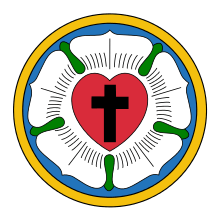Church of the Lutheran Confession
| Church of the Lutheran Confession | |
|---|---|
 | |
| Classification | Lutheran |
| Orientation | Confessional Lutheran |
| Theology | Old Lutheran[1] repristination of Lutheran Orthodoxy |
| Polity | Congregational |
| Associations | Eglise Lutherienne de Confession du Congo · Crown of Glory Lutheran Church (in Ghana) · The Church of the Lutheran Confession of India · The Berea Evangelical Lutheran Church (in India) · The Church of the Lutheran Confession of Kenya Etago · Church of the Lutheran Confession of Myanmar · Himalayan Church of the Lutheran Confession (in Nepal) · The Nigerian Church of the Lutheran Confession · The Church of the Lutheran Confession of East Africa · Eglise Evangelique Lutherienne de Confession du Togo[2] |
| Region | 24 States within the United States and various missions |
| Founder | Paul Albrecht, former District President of the Dakota-Montana district of the WELS |
| Origin |
1960 Sleepy Eye, Minnesota.[3] |
| Separated from | mainly the Wisconsin Evangelical Lutheran Synod |
| Separations | The Lutheran Church of East Africa (in Tanzania)[2] · Lutheran Conference of Confessional Fellowship[4] |
| Congregations | 85 |
| Members |
8,631 baptized[5] Foreign mission churches total about 50,000 baptized[6] |
The Church of the Lutheran Confession (CLC) is a conservative Christian religious body theologically adhering to confessional Lutheran doctrine. Founded in 1960 in Minnesota, it has approximately 85 congregations in 24 U.S. states, and missions in Canada, India, Africa, Nepal, and Myanmar.
The CLC maintains its headquarters at its ministerial college; Immanuel Lutheran High School, College & Seminary in Eau Claire, Wisconsin.
Historical background
Various Lutheran congregations left their synods during the 1950s and were independent at first. They began meeting together in 1957.[7] The Church of the Lutheran Confession (CLC) was formed around the time of the break-up of the Evangelical Lutheran Synodical Conference of North America in 1963.
The CLC was created primarily (though not solely) from congregations that broke away from the Wisconsin Evangelical Lutheran Synod (WELS) and the Evangelical Lutheran Synod (ELS) in a disagreement about the application of the principles of Christian fellowship (in this context, an agreement of a unity of belief). The CLC maintained that the WELS and ELS misapplied those principles by not breaking with the Synodical Conference and the Lutheran Church–Missouri Synod after they had publicly recognized doctrinal error within those bodies.
While there were joint talks in the 1990s between the CLC and the WELS and ELS to resolve the dispute, no resolution was reached.
Beliefs and practice
Core beliefs
The CLC teaches that the Bible is the only authoritative source for doctrine. It subscribes to the Lutheran Confessions (the Book of Concord, 1580) as an accurate presentation of what Scripture teaches. It is strongly linked to the concept of sola scriptura—scripture alone, and its website states, "If it is not Scripture; it is not Lutheran."
Ecumenical relations
Fellowship between the CLC and other church groups is established only upon investigation and confirmation that both church groups hold complete unity in scriptural doctrine and practice.
The CLC is currently in fellowship with several worldwide synods, some founded through mission work by the CLC.
Publishing and publications
The CLC Bookhouse is the official publishing house for the CLC. It is devoted to publishing Christian literature and CLC related religious materials, as well as several CLC periodicals. The CLC Bookhouse also offers books and items from other publishing houses.
CLC periodicals include:
- The Lutheran Spokesman — the CLC's monthly family magazine
- Ministry by Mail - printed and online sermons for CLC members at a distance from their church
- The Journal of Theology — a quarterly theological magazine
- The Witness - an e-newsletter
CLC educational materials include:
- God's Hand in our Lives] — the CLC Sunday School Series
- Learn From Me — an adult instruction manual
Presidents
- Paul Albrecht 1961-1972
- Robert Reim 1972-1974
- Egbert Albrecht 1974-1982
- Daniel Fleischer 1982-2002
- John Schierenbeck 2002–2012
- Michael Eichstadt 2012–present
References
- ↑ Nelson, E. Clifford. The Lutherans in North America. Revised ed. Minneapolis: Fortress Press, 1980. p. 509
- 1 2 Lutheran Missions Contact List
- ↑ Tiefel, Mark. Why Another School?: The Doctrinal History and Reasons for the Formation of Immanuel Lutheran High School, College, and Seminary. December 10, 2008. p.33, Appendix B: Timeline of Events.
- ↑ A Brief Study of the Lutheran Churches in America
- ↑ LWF Statistics 2009 Archived June 4, 2011, at the Wayback Machine.
- ↑ St. Louis Today article: The sermon's in the mail
- ↑ Tiefel, Mark. Why Another School?: The Doctrinal History and Reasons for the Formation of Immanuel Lutheran High School, College, and Seminary. December 10, 2008. p.26
